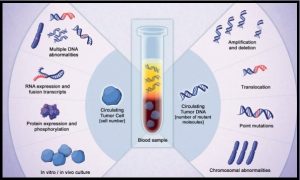SUMMARY: The FDA on January 19, 2023, granted accelerated approval to Tucatinib (TUKYSA®) in combination with Trastuzumab for RAS wild-type HER2-positive unresectable or metastatic colorectal cancer that has progressed following Fluoropyrimidine, Oxaliplatin, and Irinotecan-based chemotherapy. ColoRectal Cancer (CRC) is the third most common cancer diagnosed in both men and women in the United States. The American Cancer Society estimates that approximately 153,020 new cases of CRC will be diagnosed in the United States in 2023 and about 52,550 patients are expected to die of the disease. The lifetime risk of developing CRC is about 1 in 23.
Approximately 15-25% of the patients with CRC present with metastatic disease at the time of diagnosis (synchronous metastases) and 50-60% of the patients with CRC will develop metastatic disease during the course of their illness. First line treatment of metastatic CRC include Oxaliplatin or Irinotecan, in combination with a Fluoropyrimidine and Leucovorin (FOLFOX or FOLFIRI), along with a VEGF targeting agent such as Bevacizumab or EGFR targeting agents such as Cetuximab and Panitumumab. Patients with Stage IV colorectal cancer are now routinely analyzed for extended RAS and BRAF mutations. KRAS mutations are predictive of resistance to EGFR targeted therapy.
Human Epidermal Growth Factor Receptor 2 (HER2) is overexpressed in 3-5% of patients with RAS wild-type metastatic colorectal cancer. HER2-positive tumors are IHC3+ by Immunohistochemistry or IHC2+/FISH [Fluorescence in Situ Hybridization] amplified. There are currently no FDA-approved therapies that specifically target HER2 in colorectal cancer. Previously published studies have indicated that patients with HER2-positive CRC have less benefit from EGFR targeted therapies. In the HERACLES trial, a combination of two HER2 targeted therapies prolonged Overall Survival (OS) in RAS wild-type metastatic colorectal cancer.
Tucatinib (TUKYSA®) is an oral Tyrosine Kinase Inhibitor that is highly selective for the kinase domain of HER2, with minimal inhibition of Epidermal Growth Factor Receptor. Trastuzumab (HERCEPTIN®) is a humanized monoclonal antibody targeting HER2/neu oncogene.
MOUNTAINEER is a U.S. and European multicenter, open-label, randomized, prospective, Phase II study, conducted among patients with previously treated HER2-positive metastatic colorectal cancer. This U.S. investigator-sponsored trial initially consisted of a single cohort (Cohort A) of patients who received Tucatinib 300 mg orally BID in combination with Trastuzumab 8 mg/kg IV given as a loading dose on Cycle 1, Day 1, followed by maintenance dose of Trastuzumab 6 mg/kg IV on Day 1 every three weeks thereafter. Patients were treated until disease progression or unacceptable toxicity. This trial was subsequently expanded globally to include patients who were randomized to receive Tucatinib plus Trastuzumab (Cohort B) or Tucatinib monotherapy (Cohort C). Enrolled patients were required to have HER2-positive, RAS wild-type, unresectable or metastatic colorectal cancer and prior treatment with Fluoropyrimidine, Oxaliplatin, Irinotecan, and an anti-Vascular Endothelial Growth Factor (VEGF) monoclonal antibody. Patients whose tumors were MisMatch Repair (dMMR) deficient or were MicroSatellite Instability-High (MSI-H) must also have received an anti PD-1 monoclonal antibody. Patients who received prior anti-HER2 targeted therapy were excluded. Over two thirds of the patients had liver or lung metastases and had received a median of 3 prior lines of systemic therapy. The Primary endpoint was Objective Response Rate (ORR) as assessed by blinded Independent Central Review (ICR) in patients receiving the combination of Tucatinib and Trastuzumab (Cohorts A and B). Secondary endpoints included Duration of Response, Progression Free Survival (PFS), Overall Survival (OS) and safety and tolerability of the combination regimen.
At a median follow up of 20.7 months, the ORR among patients treated with a combination of Tucatinib and Trastuzumab (N=84) was 38.1% and the median Duration of Response was 12.4 months. The Disease Control Rate was 71.4%. The median Progression Free Survival was 8.2 months and median Overall Survival was 24.1 months. In the Cohort C patients who received Tucatinib monotherapy (N=30), the ORR by 12 weeks was 3.3% and the Disease Control Rate was 80%. Participants who did not respond to Tucatinib monotherapy by 12 weeks or had disease progressed at any time had the option to receive the combination of Tucatinib and Trastuzumab. Tucatinib in combination with Trastuzumab was well tolerated. Grade 1 or 2 diarrhea was the most common adverse event, followed by fatigue and nausea. Treatment discontinuation due to adverse events was low at 5.8%.
It was concluded that in this largest prospective trial to date among patients with chemotherapy-refractory HER2-positive metastatic colorectal cancer, Tucatinib in combination with Trastuzumab demonstrated durable and clinically meaningful antitumor activity and is a new chemotherapy-free treatment option for this group of patients. Studies are underway investigating Tucatinib plus Trastuzumab in earlier lines of therapy
MOUNTAINEER: Open-label, phase 2 study of tucatinib in combination with trastuzumab for HER2-positive metastatic colorectal cancer. Strickler JH, Cercek A, Siena S, et al: ESMO World Congress on Gastrointestinal Cancers 2022. Abstract LBA-2. Presented July 2, 2022.

